As an interior designer based in Chicago, working with clients to transform their homes brings me so much joy. But I also love the chance to flex my creative skills and further my knowledge in my own space, especially while indulging in my passion for history and architecture.
The Windy City is beloved for many styles of homes that have defined its neighborhoods throughout history, from Greystone to Victorian, Second Empire, American Foursquare, and Prairie Style. So it’s an extra special place to be working on the renovation of my family’s home – an 1890 Queen Anne Victorian we purchased in 2022, set within the Historic District in Evanston.
While there are countless types of Victorian-style houses, every one of them oozes vintage charm. Storybook features include colorful trim, stained and leaded glass, turrets, sprawling porches, and textural details. That’s why we’re on a patient journey to restore our home and bring back a period of architectural details that were stripped away over the years. All while making it a place that seamlessly functions for our family of four and serves as a showcase of our tastes.
Below, I share a bit of the restoration journey so far! It continues to teach me so much. And I hope by reading this, you walk away with some inspiration. Not only to view your surroundings as avenues for creativity but also as valuable learning experiences.
But first, let’s learn a bit about Victorian architecture & its quintessential historic charm.
Victorian design speaks to the various architectural styles that emerged during Queen Anne’s reign from the mid-to-late 19th century. This residential aesthetic can be found all over the United States, from the East Coast to San Francisco and even here in Chicago. Characterized by gabled roofs, bay windows, and intricate patterns and carvings, Victorian homes capture your attention with distinctive charm. But beyond these well-known exterior motifs, you’ll find interiors marked by maximalist design details, like ornate plasterwork, large fireplaces as focal points throughout the home (now commonly for decorative purposes rather than functional), grand staircases, and pocket doors.
The Queen Anne style of our family home gained popularity during the late 1800s as one of the final iterations of Victorian-era design. This vintage home style is seen as playful and experimental, often defined by the use of asymmetrical details and mixed materials. While ours obviously offered its fair share of charm, it also came with outdated elements that begged for modernization and personalization. Plus, we uncovered questionable design decisions from renovations that took place over the last century!
For starters, when we first moved in, it all felt SO dark and closed off – yes, even the ceilings were brown. So we got right to work on brightening up every corner. While historic houses typically have great bones and stellar features, transforming them into the comfortable, enjoyable place you desire – both today and years down the road – takes a lot of hard, hands-on effort and attention.
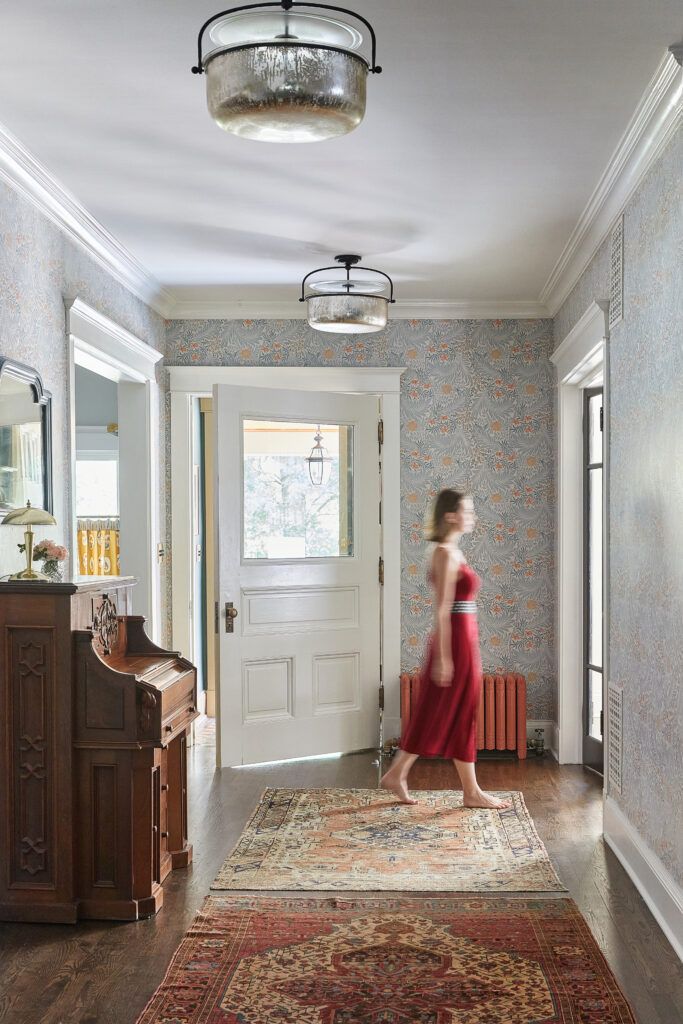
Styling: Centered by Design
Take our entry hall as an example. It had four doors – one to the office (now used as the playroom), one to the living room, one to the dining room, and one to the back family room/kitchen. And each opening was a different size, while some had doors and others didn’t. As you can imagine, it was a bit jarring to walk in and see these inconsistencies staring at you. Talk about closed off and confusing!
Given it’s the first area you see, it was important to us to make it feel more open and bright. While we appreciated the distinctiveness of separate rooms and the option to close off spaces like the playroom, we aimed for a subtle shift rather than a complete open-concept layout. And let me tell you, enlarging the doorways proved to be a transformative decision, creating a sense of spaciousness.
Now, you experience a more light and airy feeling, and there’s a sense of continuity and connection – literally and figuratively. Fresh wallpaper, paint, lighting upgrades, and styling make this manageable metamorphosis feel almost as if we’re being welcomed into a brand-new house. Regardless of these introductory refinements, our Victorian home continues to possess its own quirks and unexpected nooks that serve as nods to its history and our individuality.
Planning & Preparing for Restoring a Victorian Home
Like many challenges in life, renovating a historic home calls for expecting the unexpected. Thorough research will take you a long way. But you should also go in with the mindset that you simply can’t plan for every little thing (or hiccup). These homes have seen over a century of history. And there’s no way to know all the intricacies of their construction and maintenance. You’ll get a sense of it once you start exploring within the walls. Keyword being a sense – a glimpse; or partial view.
Here are a few quick tips for doing your due diligence when on the hunt for your ideal historic home:
- A thorough inspection is even more important in older homes. Don’t be afraid to ask questions and get second opinions when needed. We had a general inspection, then we brought on additional inspectors for the roof, fireplace, and sewer line.
- Research the style of your home and the era when it was built. The Victorian era featured a wide range of design styles influenced by the culture of the time. So for me, it was important to know both the history of the era (ex. the emergence of opulent details in homes, as more emphasis was placed on time spent inside with family), as well as the specific features of Queen Anne styles. Oh, and be sure to look into whether your community has specific rules for how original details can be changed! Ours, for instance, had to be put in front of a board to approve certain exterior changes.
- Get a sense of how it was maintained and renovated throughout the years. We LOVED a ton of original details in our home. But the massive fireplace wasn’t one of them! The original was replaced, likely in the 1950s or 60s, with a monstrous brick fireplace that we knew we’d demo when we moved in. Historic homes have often gone through multiple renovations, so you may have an identity crisis to solve.
- Get to know your local resources. Haven’t tackled many home projects before? You’ll want to get familiar with the local businesses and professionals you’ll go to for support over the next year+. We made it a priority to contract with an architect. One who was well-versed in the policies and approval process of our historic district. Plus, a general contractor who’s experienced in working with older homes has proved to be an invaluable asset to our reno team!


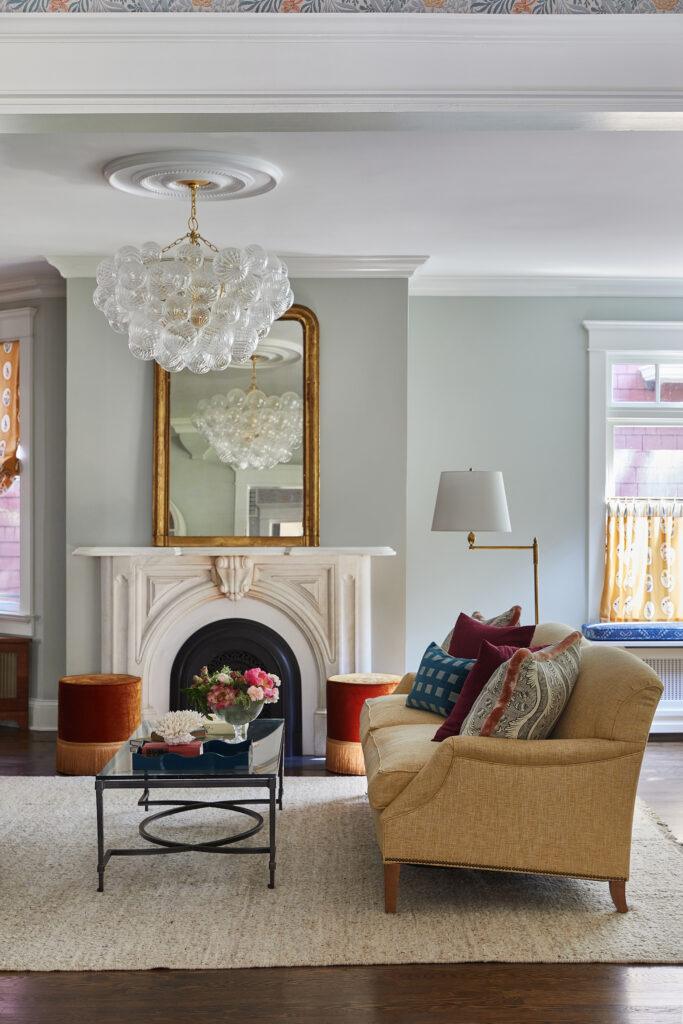
I wanted our mantel to harken back to its original era, rather than feature the 1950s mid-century modern style as a focal point. After tons of research and shopping (the vintage mantel market is surprisingly competitive!), I found our “new” old mantel at Vintage Grind House. Come to find out, it actually originated from a Chicago Greystone built the same year as our house! Now, the scale much better. Plus, it aligns perfectly with our personal style and the age of the home. It feels meant to be, like it was supposed to be there all along.
Also worth noting: while we prepared for our mantel demo, there was no way of knowing exactly what we would uncover. In this case, we discovered horsehair plaster and original wallpaper. During this era, people commonly mixed horsehair (and other animal hair) into plaster to add strength, fire resistance, soundproofing, and insulation. And to my eye, the wallpaper looks like William Morris wallpaper. Morris’s iconic designs epitomize the time when our house was built. How cool to get a glimpse into the history behind these walls!
Beyond the fireplace, some other projects we knew we needed (and wanted) to tackle shortly after purchasing the home included:
- Upgrading lighting for a cozier ambiance and brighter feel
- Stripping and repainting surfaces with lighter hues
- Infusing character and contrast into the walls with patterned wallpaper
I did look into adding wainscoting, but it exceeded our budget. In my opinion, wallpaper offers a comparable (and cost-effective!) way to add architectural appeal to the walls.

Styling: Centered by Design
Honestly, it’s amazing what fresh coats of paint, stylish wallpaper, and combining vintage details with modern lighting can do to a space. The rooms now exude a fun, uniquely contrasting atmosphere that feels like us.
Uncovering & Preserving Historic Treasures Within Your Home’s Architecture
With a Victorian house renovation, you often must evaluate which original details are worth restoring. And which ones need to be reimagined (or in some cases, replaced). Our staircase is one of my favorite original features in the house. But when we moved in, it was a very dark and unsightly brown-green color. We were committed to restoring it to its former glory!
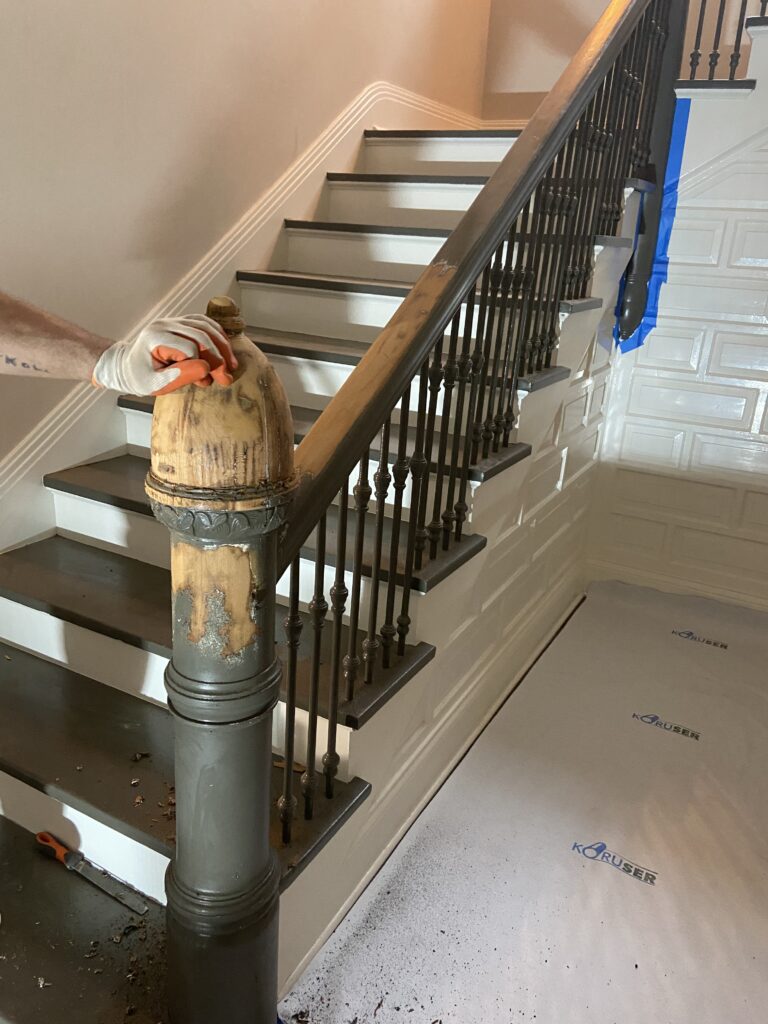
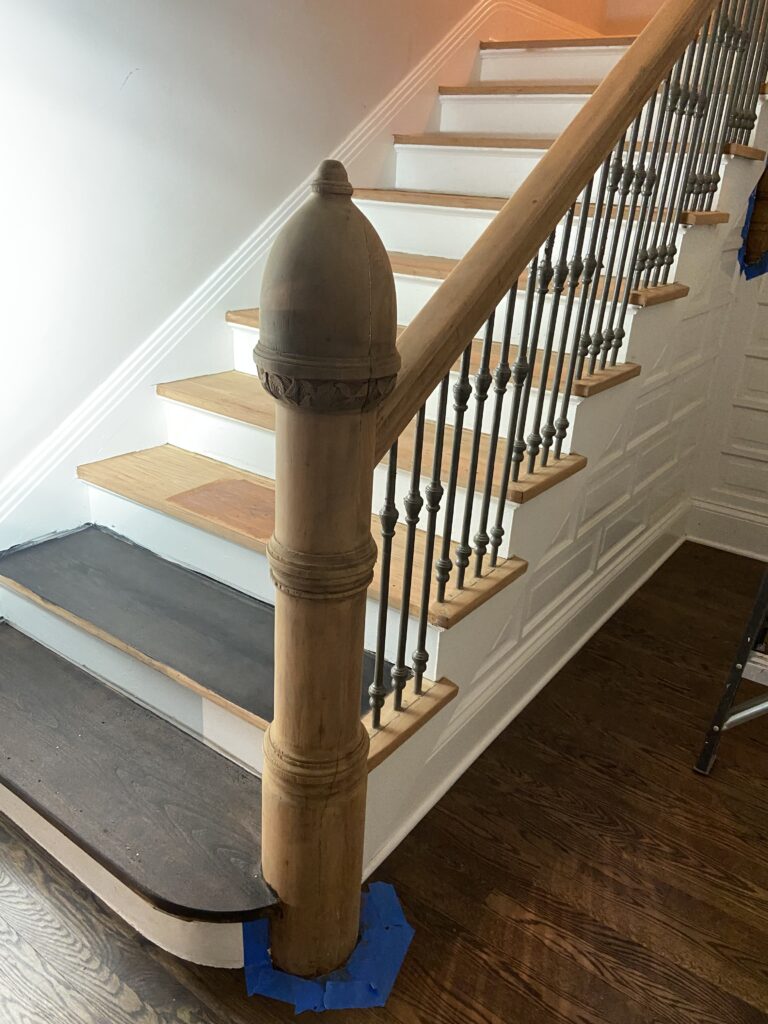
Talk about another patient part of the process. It took several days to strip the stairs. However, we knew it was well worth it as soon as we started to notice the beautiful carved details on the newel post that had been caked with countless layers of old paint.
And while we were able to restore the staircase, I had to pivot my vision part way through. My original plan was to stain it a walnut color like our floors. Although the stairs are made of maple (which has a very red undertone). So it made sense to go darker with an ebony stain. Not what I’d initially envisioned, but I love how it contrasts with our interior paint and wallpaper. What do you think?
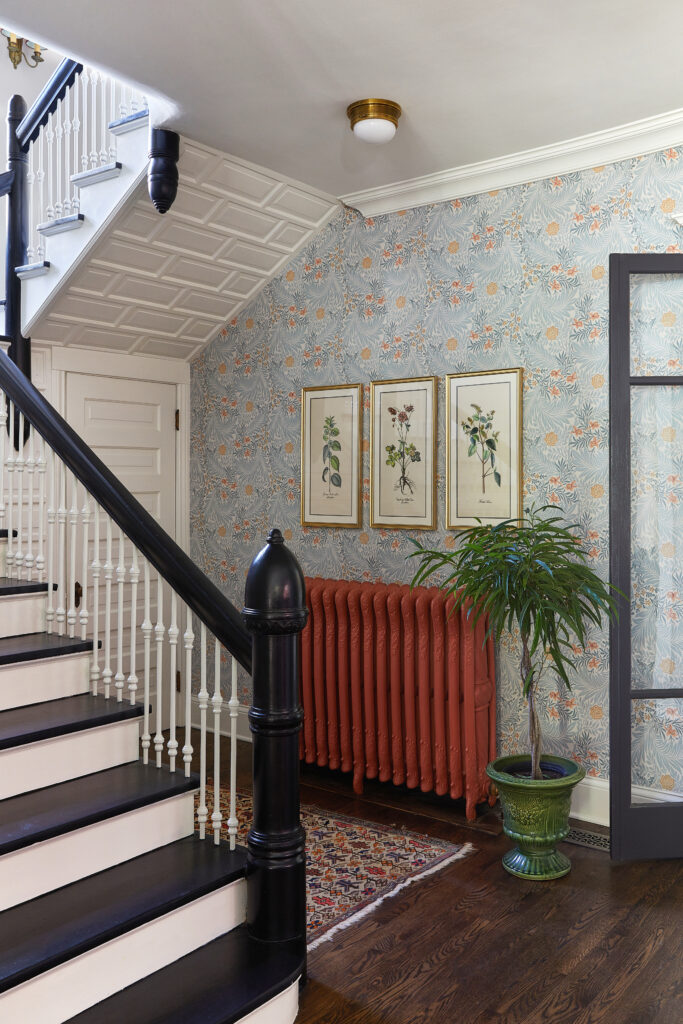
Styling: Centered by Design
Did seeing some of the original character stripped away during remodels over the years feel slightly disheartening? Of course. But through this process, I’ve found gratitude for the enduring details that have been preserved, like the exquisite built-in and charming leaded glass windows gracing our office nook! Also worth noting is the beautiful original wall paneling in the stairwell.
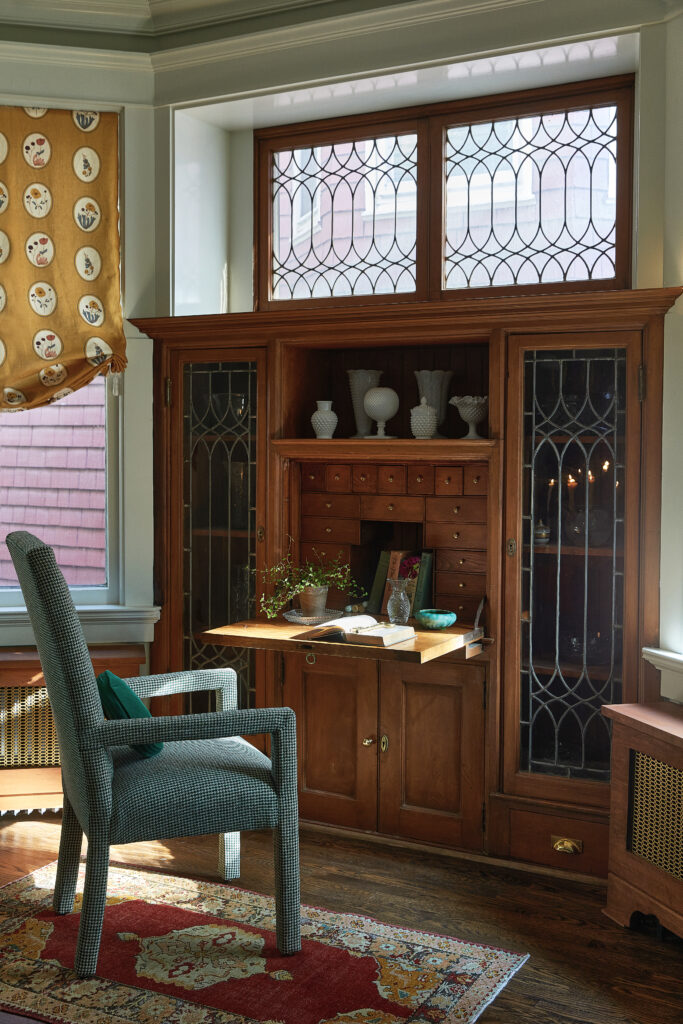
Styling: Centered by Design
Modernizing Your Historic Home for Comfort & Functionality
Speaking of, renovating a historic home is truly a labor of love. It requires an appreciation of and passion for preservation. At the same time, it’s perfectly okay to mix old with new. And often, it’s necessary!
Determining which elements to highlight, rework, or remove is all part of the process. By carefully weaving in modern elements with the original features, we not only pay homage to the past but also ensure the home remains relevant and functional for modern living. This harmonious combination creates a unique narrative of both the home’s heritage and the present-day residents.
For us, updating the lighting was one of the first ways we chose to balance historic charm with today’s comforts and conveniences. I also reimagined certain nooks to be more functional for our needs, such as refreshing my daughter’s personal space.
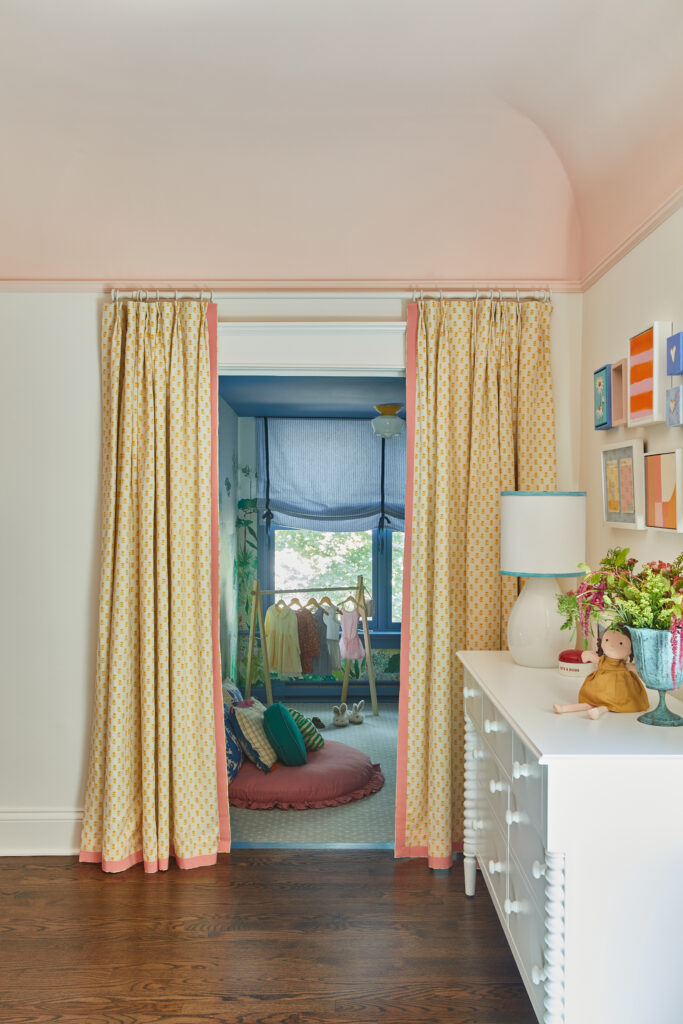
Styling: Centered by Design
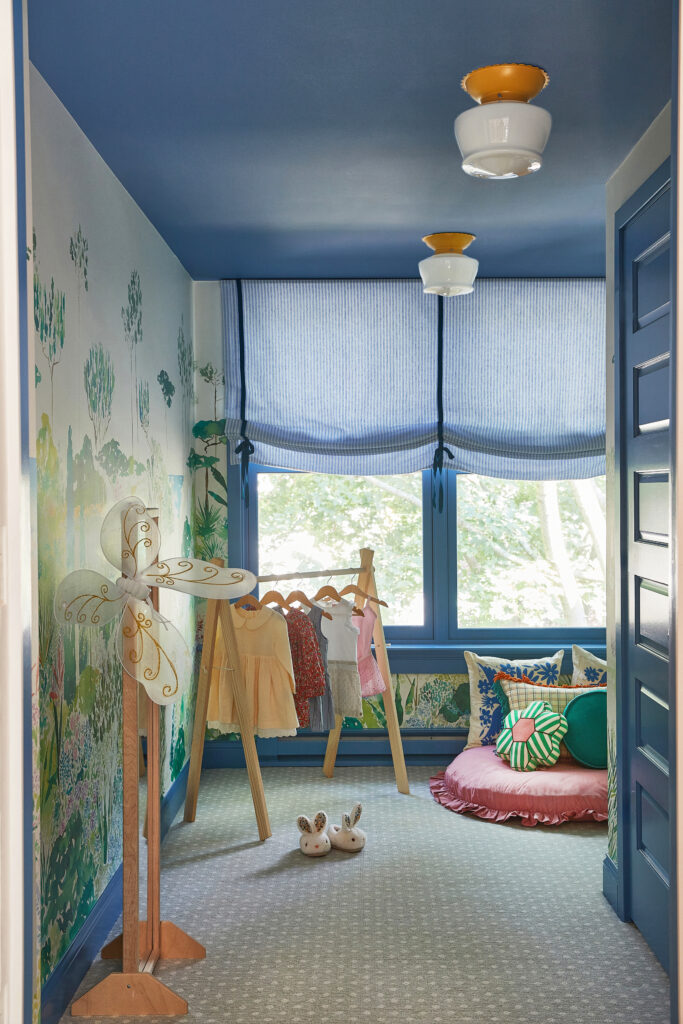
Styling: Centered by Design
Originally, this part of my daughter’s room was a sleeping porch. Fun fact: in the Victorian period, residents had exterior porches they’d sleep in to catch a bit of Lake Michigan breeze! At some point, someone enclosed and winterized it. I knew right away that I wanted to create a magical space for her that was playful but also functional for modern use.
I hung draperies at the entrance to the porch to create a fun reveal (which the kids also use as a theater curtain). And I selected the Isidore Leroy mural, which makes you feel like you’ve stepped right into a French garden. It’s now a sweet little dress-up area – one where I can already picture Charlotte doing her homework, and dare I say, her makeup?
Next up? We plan to tackle another series of projects that will further modernize our home (while celebrating its historic charm, of course!), such as designing a built-in bed nook in our attic guest room, updating my office with custom built-ins, and renovating bathrooms.
While the list of desires and tasks may seem daunting, it’s essential to remember that this is our home. A place where progress unfolds gradually, not overnight. It’s a journey that will evolve alongside us for as long as we live here, and I’m deeply appreciative of the chance to weave our narrative into the very fabric of these walls. I encourage you to look at your historic home and renovation journey in a similar way!
Have you landed here while in the process of a historic reno, or are you contemplating the purchase of a historic home in Chicago or beyond? Feel free to send a DM on Instagram or email me to swap stories and support each other. I can’t wait to share more of our Victorian home renovation with you!